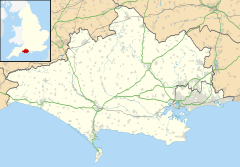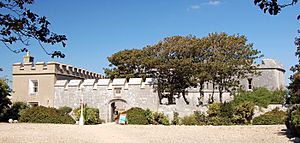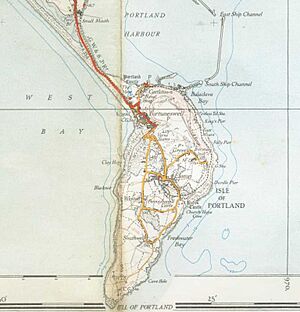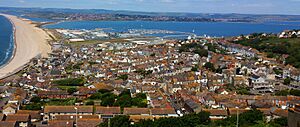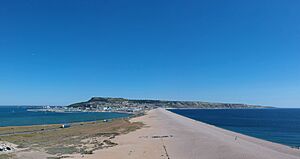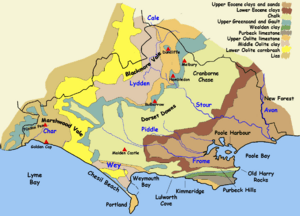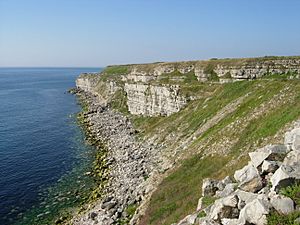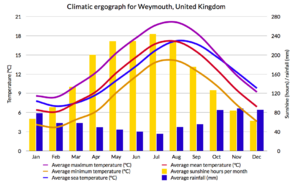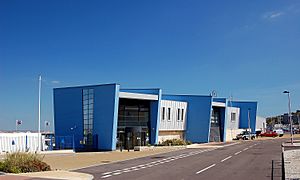Isle of Portland facts for kids
Quick facts for kids Isle of Portland |
|
|---|---|
 The Isle of Portland viewed from Portland Harbour |
|
 Flag of the Isle of Portland |
|
| Population | 13,417 (2021 est.) |
| OS grid reference | SY690721 |
| • London | 121 miles (195 km) NE |
| Civil parish |
|
| Unitary authority |
|
| Ceremonial county | |
| Region | |
| Country | England |
| Sovereign state | United Kingdom |
| Post town | PORTLAND |
| Postcode district | DT5 |
| Dialling code | 01305 |
| Police | Dorset |
| Fire | Dorset |
| Ambulance | South Western |
| EU Parliament | South West England |
| UK Parliament |
|
The Isle of Portland is a special place in the English Channel. It's not quite an island because it's connected to mainland England by a long beach called Chesil Beach. Portland is about 6 kilometres (4 mi) long and 2.7 kilometres (1.7 mi) wide.
This unique island is the southernmost point of Dorset, England. It's also a key part of the Jurassic Coast, a World Heritage Site famous for its amazing geology and landforms. About 13,417 people live on Portland.
One of the most famous things from Portland is Portland stone. This special type of limestone has been used to build famous buildings all over the world. You can see it in St Paul's Cathedral in London and even the United Nations Headquarters in New York! Quarries on the island still dig up this stone today.
Portland Harbour, located between Portland and Weymouth, is one of the biggest man-made harbours in the world. It was built with huge stone walls called breakwaters between 1848 and 1905. For a long time, it was an important base for the Royal Navy and played a big part in both the First and Second World Wars. Today, it's a busy civilian port and a popular spot for fun activities on the water. It was even used for the 2012 Olympic Games sailing events!
The name Portland is so well-known that it's used for one of the British Sea Areas (like a weather zone at sea). Many towns in North America and Australia are also named Portland.
Contents
A Look Back: Portland's History
Portland has been home to people for a very long time, since the Mesolithic period (the Middle Stone Age). Archaeologists have found proof of these early people near Portland Bill. The Romans also lived here, supposedly calling the island Vindelis.
The Viking Age in England began with a raid in 793. But the very first time Vikings were officially recorded landing in England was on Portland in 789. Three Viking ships from Norway landed at Portland Bill. The local official tried to collect taxes from them, but the Vikings killed him and sailed away.
A castle, possibly built for William II of England (also known as William Rufus) after his father conquered England, once stood where Rufus Castle is today. The castle you see now probably dates from the 15th century.
In 1539, King Henry VIII ordered Portland Castle to be built. This was to protect the island from French attacks. It's one of the best-preserved castles from that time and is now open to the public.
In the 1600s, a famous architect named Inigo Jones brought Portland stone to London. He used it for buildings like the Banqueting House, Whitehall. Later, Sir Christopher Wren, another famous architect, used millions of tons of Portland stone to rebuild London after the Great Fire of London in 1666. Many well-known buildings, including St Paul's Cathedral and Buckingham Palace, feature this stone.
After the World Wars, quarries on Portland provided stone for memorials and gravestones for soldiers. Interestingly, Portland cement has nothing to do with the island. It was named that because its color looked similar to Portland stone when mixed with other materials.
Portland has had railways since the early 1800s. The Merchant's Railway, opened in 1826, carried Portland stone from the quarries to a pier at Castletown. From there, the stone was shipped across the country. Later, the Weymouth and Portland Railway opened in 1865, connecting the island to the mainland. This line was extended to the top of the island by the end of the 19th century. The railway stopped carrying passengers in 1952 and closed completely in 1965.
The Royal National Lifeboat Institution (RNLI) had a lifeboat stationed at Portland in 1826. Coastal flooding has always been a challenge for Portland. The only road off the island can get cut off by floods during very bad storms. The village of Chiswell used to flood often. To protect the area, special walls and channels were built in the 1980s to help control floodwaters.
During World War I, a ship called HMS Hood was sunk in the harbour entrance to protect it from torpedo attacks. Portland Harbour was a major naval base for over 500 years. It was also a center for researching submarine detection. During World War II, Portland was bombed many times. It was also a key starting point for Allied forces on D-Day in 1944.
The naval base closed in 1995 after the Cold War. The Royal Naval Air Station, which was a big helicopter base, closed in 1999. However, the runway was still used for Search and Rescue flights until 2014.
Today, Portland has two prisons: HMP The Verne, which was a military fortress, and a Young Offenders' Institution.
How Portland is Governed
Since 2019, Portland is part of the Dorset unitary authority. This means it's managed by the Dorset Council. The whole island is one area, called the Portland ward, and it elects three people to the council.
Portland used to be a separate area for local government. It was an urban district from 1894 to 1974. Then it joined with Weymouth to form the borough of Weymouth and Portland. In 2020, this borough was changed when Dorset moved to a new system of local government.
Portland is in the South Dorset area for national elections. This area elects one Member of Parliament (MP) to the UK Parliament.
Portland's Geography and Nature
The Isle of Portland is in the English Channel, about 3 kilometres (2 mi) south of Wyke Regis. It's part of the UNESCO Jurassic Coast World Heritage Site, which stretches for 153 kilometres (95 mi) along the Dorset and east Devon coast. This area is famous for its amazing rocks and landforms. The South West Coast Path, a very long walking trail, goes all around the coast of Portland.
Portland is connected to the mainland by Chesil Beach. This beach is a tombolo, which is a sand or shingle spit that connects an island to the mainland. So, Portland is a "tied island," and Chesil Beach is the tombolo itself.
There are eight main villages on Portland. The biggest ones are Fortuneswell and Easton. Many old buildings are made from Portland Stone. Some areas are protected to keep the unique look of these old villages.
Portland's Geology
Portland is divided into two main parts: Underhill at the north, which is steep, and Tophill to the south, which slopes gently. Portland stone is found under Tophill. Underhill has different rocks, including Portland Sand and a thick layer of Kimmeridge Clay. This clay has caused landslides over time, creating areas like West Weares and East Weares.
Deep under south Dorset, there's a layer of rock salt. Portland is one of the few places in the UK where this salt is thick enough to create stable underground spaces. There were plans to dig 14 huge caverns here to store natural gas, which would have been a big project.
Portland Bill: The Southern Tip

Portland Bill is the very southern tip of the island. It has three lighthouse towers. The Old Higher Lighthouse is now a home, and the Old Lower Lighthouse is a bird observatory. The main white and red lighthouse was built in 1906. It's a famous landmark and helps guide ships past the headland and its strong currents. You can even visit a center there and take tours of the lighthouse.
Portland Race: Strong Currents
Under the water, Portland stone extends into the English Channel. This underwater ridge, called Portland Ledge, causes a very strong current known as the Portland Race. The water here can flow very fast, up to 4 metres per second (9 mph) during spring tides. It's a challenging area for ships.
Amazing Plants and Animals
Because Portland is an isolated island, it has a wide variety of plants and animals. The coastline and old quarries are protected areas, known as Sites of Special Scientific Interest. These areas are home to Jurassic fossils, special grasslands, and rare butterflies.
Many sea birds and migrating birds visit the cliffs. Sometimes, rare bird species appear, attracting bird watchers from all over the country. Dolphins, seals, and basking sharks can sometimes be seen in the surrounding seas. Chesil Beach is one of only two places in Britain where you can find the scaly cricket, a unique wingless cricket that doesn't sing or hop.
The warm, sunny climate on Portland allows special plants to grow that don't thrive on the mainland. The limestone soil has low nutrients, so smaller wildflowers and grasses can grow well. The Portland sea lavender, found only on the higher sea cliffs, is one of the UK's rarest plants. These wildflowers create a perfect home for butterflies. More than half of the British Isles' 57 butterfly species can be seen on Portland, including some rare ones that migrate from Europe.
Portland's Climate
The sea surrounding Portland keeps the climate mild. Temperatures don't change much between day and night or throughout the year. The average yearly temperature is about 11.5 °C (52.7 °F). August is the warmest month, and February is the coolest. Winters are among the mildest in the British Isles. Summers are cooler than the national average because of the sea.
| Climate data for Isle of Portland climatic averages | |||||||||||||
|---|---|---|---|---|---|---|---|---|---|---|---|---|---|
| Month | Jan | Feb | Mar | Apr | May | Jun | Jul | Aug | Sep | Oct | Nov | Dec | Year |
| Mean daily maximum °C (°F) | 8.7 (47.7) |
8.4 (47.1) |
9.7 (49.5) |
11.9 (53.4) |
14.5 (58.1) |
17.0 (62.6) |
19.0 (66.2) |
19.5 (67.1) |
18.1 (64.6) |
15.0 (59.0) |
11.9 (53.4) |
9.6 (49.3) |
13.6 (56.5) |
| Daily mean °C (°F) | 6.9 (44.4) |
6.6 (43.9) |
7.7 (45.9) |
9.4 (48.9) |
12.0 (53.6) |
14.6 (58.3) |
16.6 (61.9) |
17.1 (62.8) |
15.7 (60.3) |
13.1 (55.6) |
10.1 (50.2) |
7.8 (46.0) |
11.5 (52.7) |
| Mean daily minimum °C (°F) | 5.2 (41.4) |
4.7 (40.5) |
5.6 (42.1) |
7.0 (44.6) |
9.5 (49.1) |
12.2 (54.0) |
14.3 (57.7) |
14.8 (58.6) |
13.4 (56.1) |
11.1 (52.0) |
8.2 (46.8) |
6.0 (42.8) |
9.4 (48.9) |
| Average rainfall mm (inches) | 74.1 (2.92) |
52.7 (2.07) |
46.3 (1.82) |
47.6 (1.87) |
42.7 (1.68) |
41.1 (1.62) |
36.9 (1.45) |
47.2 (1.86) |
46.2 (1.82) |
76.4 (3.01) |
82.6 (3.25) |
78.6 (3.09) |
672.3 (26.47) |
| Average rainy days (≥ 1 mm) | 12.3 | 10.5 | 9.1 | 8.6 | 8.0 | 7.2 | 6.4 | 8.0 | 8.0 | 12.0 | 13.4 | 12.6 | 116.1 |
| Mean monthly sunshine hours | 66.7 | 90.5 | 134.0 | 192.2 | 228.5 | 230.3 | 237.4 | 212.4 | 172.5 | 116.1 | 80.1 | 62.2 | 1,822.6 |
| Source: 1991–2020 averages for the Isle of Portland climate station and Weymouth Cefas station. Sources: Met Office and Cefas | |||||||||||||
Because of the mild seas, it rarely freezes on Portland, with only about 6 days of frost per year. Snow is also very rare. Portland gets more sunshine than most of the UK, averaging over 1800 hours a year. July is usually the sunniest and driest month.
Portland's People
| Religion | % |
|---|---|
| Buddhist | 0.4 |
| Christian | 61.0 |
| Hindu | 0.1 |
| Jewish | 0.1 |
| Muslim | 0.5 |
| No religion | 29.3 |
| Other | 0.7 |
| Sikh | 0.1 |
| Not stated | 7.9 |
| Age | Percentage |
|---|---|
| 0–15 | 18.1 |
| 16–17 | 2.4 |
| 18–44 | 33.5 |
| 45–59 | 21.9 |
| 60–84 | 21.7 |
| 85+ | 2.3 |
| Year | Population |
|---|---|
| 1971 | 12,330 |
| 1981 | 12,410 |
| 1991 | 13,190 |
| 2001 | 12,800 |
| 2010 | 12,400 |
| 2011 | 12,869 |
| 2012 | 12,806 |
| 2013 | 12,966 |
| 2014 | 12,603 |
| 2015 | 12,501 |
| 2016 | 12,627 |
| 2017 | 12,721 |
| 2018 | 12,797 |
| 2021 | 13,417 |
In 2021, the population of Portland was 13,417 people. This number has stayed around 12,000 to 13,000 since the 1970s. Most residents are from the United Kingdom.
Getting Around Portland
The A354 road is the only way to get to Portland by land. It crosses a bridge over the Fleet Lagoon and connects to Weymouth. From there, you can reach the wider road network. There used to be a railway line, but now that path is used for walking and cycling.
Local buses run by FirstGroup connect Portland to Weymouth. Weymouth is a hub for bus routes across south Dorset. There's also a special Jurassic Coast Bus service that runs along the coast, connecting many towns and villages. Trains from Weymouth go to London, Southampton, and other cities.
Learning on Portland
St George's Community Primary School is in Easton. The other main school on Portland is the Atlantic Academy. This school teaches students from age 3 to 19 on two different sites. It was formed in 2012 by combining several primary schools and one secondary school.
Some older students travel to Weymouth or Dorchester for further education. Weymouth College is the nearest college, offering many courses, including A-Levels.
Portland's Culture and Fun
Sports and Activities
In 2000, the Weymouth and Portland National Sailing Academy was built. It's a top center for sailing in the UK. The waters around Weymouth and Portland are known as some of the best for sailing in Northern Europe. Many local, national, and international sailing events are held here.
In 2005, the Academy was chosen to host the sailing events for the 2012 Summer Olympic Games. A new marina and more facilities were built, and it was the first Olympic venue to be completed!
Weymouth Bay and Portland Harbour are also great for other water sports. The strong winds are perfect for wind and kite-surfing. You can also go angling, scuba diving to shipwrecks, snorkeling, canoeing, and swimming. The limestone cliffs and quarries are popular for rock climbing, especially sport climbing. The South West Coast Path also offers great coastal walks around the island.
Portland has a local football club called Portland United F.C. They play at Grove Corner and also have a youth team.
The Rabbit Superstition
Rabbits have long been linked to bad luck on Portland. People on the island often avoid saying the word "rabbit." Instead, they might call them "underground mutton" or "long-eared furry things." This superstition likely comes from quarry workers. They believed that if rabbits came out of their burrows, it meant a rockfall was about to happen. If a rabbit was seen, workers would go home until the area was safe.
Even today, some older Portland residents might pretend to be offended if you say "rabbit." This superstition became famous in 2005 when a movie called Wallace & Gromit: The Curse of the Were-Rabbit was released. Out of respect for the local belief, the movie's posters on Portland changed the title to "Something bunny is going on"!
Portland in Books
Many writers have been inspired by Portland. Thomas Hardy called it "the peninsula carved by Time out of a single stone." He used it as the main setting for his novel The Well-Beloved, calling it the Isle of Slingers. He also called Portland the Gibraltar of the North because it's similar to Gibraltar in its geography and isolation.
A. E. Housman wrote a poem about it called "The Isle of Portland." Hilaire Belloc described the dangerous Portland Race in his book The Cruise of the "Nona".
Jonathan Meades said Portland is "a bulky chunk of geological, social, topographical and demographic weirdness. It is awesome."
In the The Warlord Chronicles by Bernard Cornwell, Portland is imagined as the "Isle of the Dead," a place where people with mental illness were sent. However, there's no historical proof for this idea.
Local author Carol Hunt wrote the "Portland Chronicles" series of children's books, which are set on the island and explore its history of smuggling and piracy.
Local Words
- Kimberlin: This is a slang word for people who live on the island but weren't born there.
- Portland screw: This refers to a type of fossil mollusc found on the island, which has a long, screw-like shell.
Famous People from Portland
- Eddie Argos, the lead singer of the rock band Art Brut.
- Edgar F. Codd, a British computer scientist who invented an important way to manage databases.
- Paul Durkin, a former Premier League football referee.
- Pat Comben, a former politician from Queensland, Australia.
See also
 In Spanish: Isla de Pórtland para niños
In Spanish: Isla de Pórtland para niños


